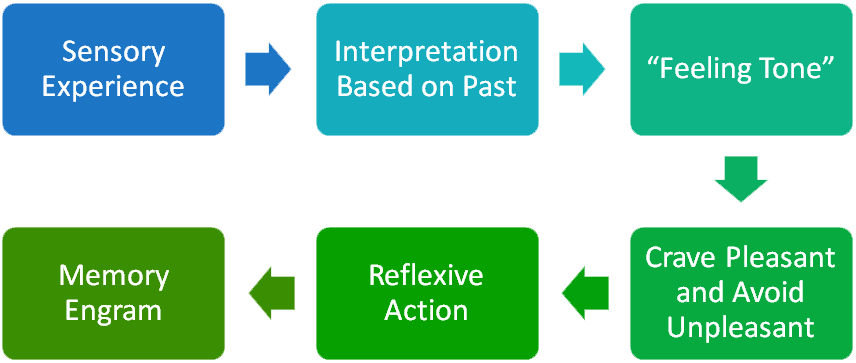When the earliest incarnations of human beings roamed the earth, survival loomed large in every day life. Those who lived became adept at laying down patterns of behavior in response to environmental cues. Establish relationship with friends; run from enemies and predators. Move toward nutrients and away from toxins. Approach pleasant; avoid unpleasant. Memory engrams combined with dopamine hits in the brain codified these patterns into habits. Good habits kept one alive.
With our ancient brains now living in a modern world, that evolutionarily beneficial learning process now works against us. While we don’t face the same environmental threats, our brains still run the same programming:
- We have an experience that registers in the five senses (sight, smell, sound, taste, touch) and/or our emotions.
- We render an interpretation of that stimulus based on past experience.
- Our assessment results in a “feeling tone” – i.e., pleasant or unpleasant.
- We’re wired to approach (and crave) what’s pleasant and avoid (or ignore) what’s unpleasant.
- We take action reflexively based on this rapid and largely unconscious mental process.
- We lay down a memory engram that increases the likelihood that we’ll repeat the process the next time we encounter that stimulus… as well as ones that register as similar.
Feel stressed, bored, frustrated, angry? Our patterned behavior might trigger eating, drinking, smoking, doing drugs, checking social media… anything to distract ourselves from the unpleasant feeling. But here’s the rub: However pleasant these distractions may seem, we’ll only get a transitory hit of dopamine when pursuing them. Worst yet, the hit attenuates the more we chase after that activity, thereby requiring a more extended engagement for the same measure of pleasure. And when it wears off, we’re still left with whatever feeling we had when we hopped on the bad habit bandwagon.
Dr. Judson Brewer explores this terrain in The Craving Mind: From Cigarettes to Smartphones to Love. In particular, his research focuses on the neurobiology of substance and behavioral addiction and its treatment via mindfulness. It’s a really interesting read. Let me illustrate a small piece of his work through the lens of social media.
Using fMRI technology, neuroscientists have identified the nucleus accumbens as the brain region linked with addiction. It also lights up when we talk about ourselves, listen to others talk about us, or get self-relevant feedback. This wiring likely reflects the fact that our ancestors increased their chances of survival when they mattered to others. It meant that others took a vested interest in their well-being under the auspices of mutual interest.
Technology causes us to overuse this neural pathway. We post on social media to get noticed and pay close attention to who “likes” what we shared. We feel great if a lot of people give us a thumbs up – especially those who we deem special – and feel deflated if few bother to register a response. Ironically, extensive use of social media has been correlated with diminished self-worth and increased withdrawal. We get caught up in comparisons, ruminating on how others’ lives are so much more exciting than ours. We get drawn in to the on-line world rather than revel in real experience. We want to matter. But in the end, social media makes us feel worse.
So, what’s the answer?
Dr. Brewer suggests a counterintuitive response: Lean in to the discomfort rather than attempt a bypass through addictive distraction. Activate curiosity to see how discomfort manifests in the body. Curiosity creates emotional distance from the sensation and makes it less personal. It also affords the space to “pause” before engaging in habitual responses and see what we’re actually getting out of them. Do we really feel better long term, or are we just getting some temporary relief and winding up worse off? Moreover, given time, we may notice that our impulse to act – out of craving or aversion – likely reaches a peak and then falls away. If we just stay with it, we can ride the wave until it finds its own natural conclusion.
I’ve put this advice into practice. Sweets – notably chocolate truffles and ice cream – are my go-to “remedies” for stress, boredom, and various forms of upset. Sugar alone triggers an addictive response; my use of it for palliative care makes it doubly vexing. When I give in to the craving, the sensory experience lasts but a few minutes. Then I experience a sugar rush followed by a crash and (usually) disruption of sleep. And after my brief distraction, I still have to deal with whatever triggered the habit loop in the first place… with diminished physical reserves.
Using Dr. Brewer’s advice, I stop and take notice when craving for sweets arises. I remind myself of the fleeting nature of the “happiness hit” and the long tail of the unpleasantness post-indulgence. Then I get quiet and explore what’s really going on in my body and what it might be telling me about my life. With that little bit of mindfulness, I set myself up for right action.
